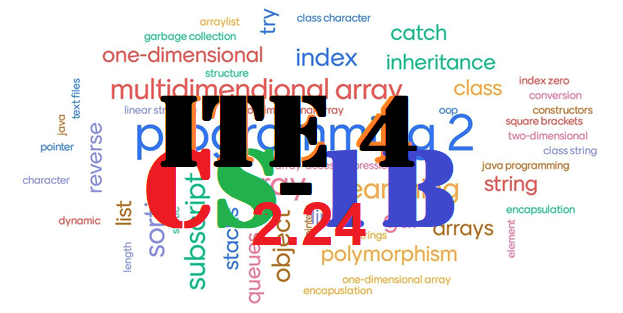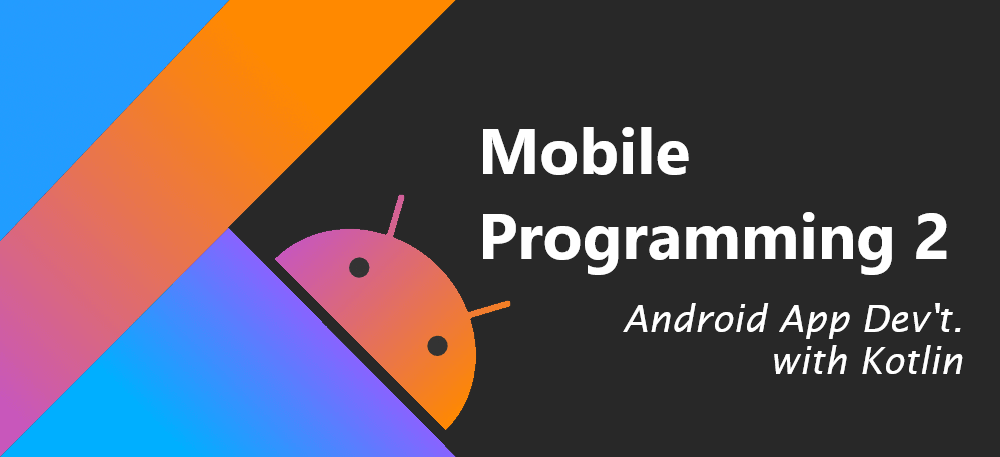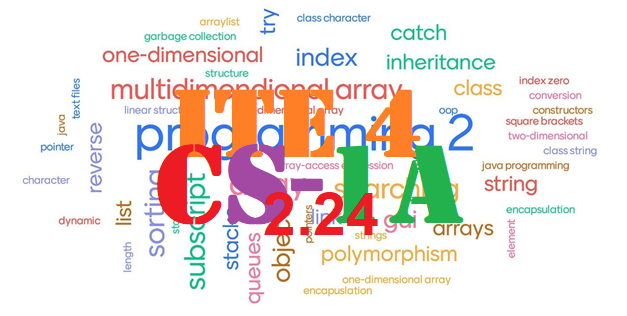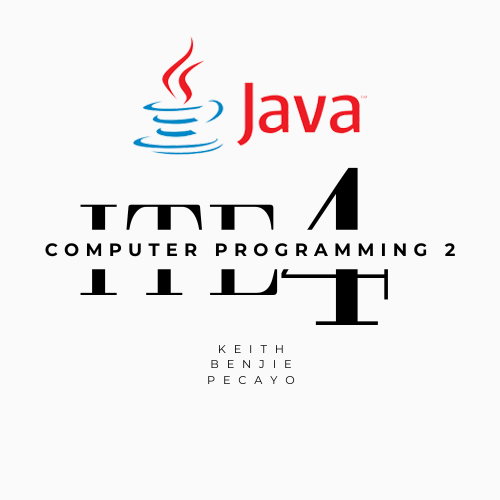test
- Teacher: Aaron Jude Pael
test

The course covers the use of general purpose programming language to solve problem. The emphasis is to train students to design, implement, test, and debug programs intended to solve computing problems using advance programming.
This course teaches the students on to how to develop new computer programs using array, string, structure, pointers, heap, stacks, memory, polymorphism and inheritance.
At the end of the course, each students are required to design a program that maybe implemented as a solution to a given problem with the topics array, string, structure, pointers, heap, stacks, memory, polymorphism and inheritance. Also submit all activities (i.e. laboratory/hands-on exercises, classroom activities, and performance activities).

Mobile Programming 2 is a continuation of the foundational skills learned in Mobile Programming 1, designed to advance students' skills in Android app development. This course focuses on enhancing students' proficiency in building robust, user-centric mobile applications by exploring advanced topics in Android programming. Topics include App UI/UX design principles, Advanced use case of RecyclerView, Android Permissions, network resources with Retrofit and Moshi, displaying images using Glide, Repository Pattern, and WorkManager.
By the end of the course, students will integrate all the skills and concepts learned to design and build mobile application solutions for real-world problem scenarios, demonstrating their ability to address complex challenges through advanced Android development techniques.

Mobile Programming 2 is a continuation of the foundational skills learned in Mobile Programming 1, designed to advance students' skills in Android app development. This course focuses on enhancing students' proficiency in building robust, user-centric mobile applications by exploring advanced topics in Android programming. Topics include App UI/UX design principles, Advanced use case of RecyclerView, Android Permissions, network resources with Retrofit and Moshi, displaying images using Glide, Repository Pattern, and WorkManager.
By the end of the course, students will integrate all the skills and concepts learned to design and build mobile application solutions for real-world problem scenarios, demonstrating their ability to address complex challenges through advanced Android development techniques.

Mobile Programming 2 is a continuation of the foundational skills learned in Mobile Programming 1, designed to advance students' skills in Android app development. This course focuses on enhancing students' proficiency in building robust, user-centric mobile applications by exploring advanced topics in Android programming. Topics include App UI/UX design principles, Advanced use case of RecyclerView, Android Permissions, network resources with Retrofit and Moshi, displaying images using Glide, Repository Pattern, and WorkManager.
By the end of the course, students will integrate all the skills and concepts learned to design and build mobile application solutions for real-world problem scenarios, demonstrating their ability to address complex challenges through advanced Android development techniques.

Mobile Programming 2 is a continuation of the foundational skills learned in Mobile Programming 1, designed to advance students' skills in Android app development. This course focuses on enhancing students' proficiency in building robust, user-centric mobile applications by exploring advanced topics in Android programming. Topics include App UI/UX design principles, Advanced use case of RecyclerView, Android Permissions, network resources with Retrofit and Moshi, displaying images using Glide, Repository Pattern, and WorkManager.
By the end of the course, students will integrate all the skills and concepts learned to design and build mobile application solutions for real-world problem scenarios, demonstrating their ability to address complex challenges through advanced Android development techniques.

Mobile Programming 2 is a continuation of the foundational skills learned in Mobile Programming 1, designed to advance students' skills in Android app development. This course focuses on enhancing students' proficiency in building robust, user-centric mobile applications by exploring advanced topics in Android programming. Topics include App UI/UX design principles, Advanced use case of RecyclerView, Android Permissions, network resources with Retrofit and Moshi, displaying images using Glide, Repository Pattern, and WorkManager.
By the end of the course, students will integrate all the skills and concepts learned to design and build mobile application solutions for real-world problem scenarios, demonstrating their ability to address complex challenges through advanced Android development techniques.

Mobile Programming 2 is a continuation of the foundational skills learned in Mobile Programming 1, designed to advance students' skills in Android app development. This course focuses on enhancing students' proficiency in building robust, user-centric mobile applications by exploring advanced topics in Android programming. Topics include App UI/UX design principles, Advanced use case of RecyclerView, Android Permissions, network resources with Retrofit and Moshi, displaying images using Glide, Repository Pattern, and WorkManager.
By the end of the course, students will integrate all the skills and concepts learned to design and build mobile application solutions for real-world problem scenarios, demonstrating their ability to address complex challenges through advanced Android development techniques.

Mobile Programming 2 is a continuation of the foundational skills learned in Mobile Programming 1, designed to advance students' skills in Android app development. This course focuses on enhancing students' proficiency in building robust, user-centric mobile applications by exploring advanced topics in Android programming. Topics include App UI/UX design principles, Advanced use case of RecyclerView, Android Permissions, network resources with Retrofit and Moshi, displaying images using Glide, Repository Pattern, and WorkManager.
By the end of the course, students will integrate all the skills and concepts learned to design and build mobile application solutions for real-world problem scenarios, demonstrating their ability to address complex challenges through advanced Android development techniques.
This course discusses the WAN technologies and network services required by converged applications in a complex network. The course enables students to understand the selection criteria of network devices and WAN technologies to meet network requirements. Students learn how to configure and troubleshoot network devices and resolve common issues with data link protocols. Students will also develop the knowledge and skills needed to implement virtual private network (VPN) operations in a complex network.

The course covers the use of general purpose programming language to solve problem. The emphasis is to train students to design, implement, test, and debug programs intended to solve computing problems using advance programming.
This course teaches the students on to how to develop new computer programs using array, string, structure, pointers, heap, stacks, memory, polymorphism and inheritance.
At the end of the course, each students are required to design a program that maybe implemented as a solution to a given problem with the topics array, string, structure, pointers, heap, stacks, memory, polymorphism and inheritance. Also submit all activities (i.e. laboratory/hands-on exercises, classroom activities, and performance activities).
Networking II focuses on switching technologies and router operations that support small-to-medium business networks and includes wireless local area networks (WLANs) and security concepts. Students learn key switching and routing concepts. They can perform basic network configuration and troubleshooting, identify and mitigate LAN security threats, and configure and secure a basic WLAN.

This course is a continuation of Computer Programming 1. The emphasis is to train students to design, implement, test, and debug programs intended to solve computing problems using basic data structures and standard libraries.
By the end of this course, students will be able to develop efficient and reliable software solutions, apply fundamental programming concepts and data structures, and utilize standard libraries to create well-structured and maintainable code for a variety of computational problems.